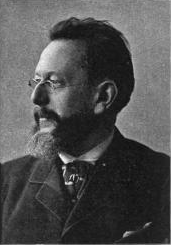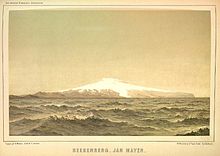Henrik Mohn
Henrik Mohn (born May 15, 1835 in Bergen , Norway , † September 12, 1916 in Kristiania , Norway) was a Norwegian meteorologist and oceanographer.
He is considered to be the founder of meteorology and oceanography in Norway. He was the first professor of meteorology at Christiania University and the first director of the Royal Norwegian Meteorological Institute. Mohn initiated and led the Norwegian North Sea Expedition from 1876 to 1878 together with Georg Ossian Sars. He represented his country in the International Polar Commission, which organized the First International Polar Year , and processed the meteorological material of the three Norwegian polar expeditions with the Fram .
Life
Henrik Mohn was the oldest of 13 children by Albert Henrik Mohn (1811–1894) and his wife Adelaide Charlotte Augusta Mohn, nee. Neumann (1814-1864). He attended the cathedral school in Bergen until 1852 and then began studying theology at the Royal Friedrichs University Christiania . He soon discovered his interest in physics and took the subjects of astronomy and mineralogy. He completed his studies in 1858 as a mountain candidate ( candidatus mineralogiae ). From 1859 to 1862 he was editor of the magazine Polyteknisk Tidsskrift . In 1860 he received the Kronprinzen Gold Medal ( Kronprinsens gullmedalje ), the university's highest honor, for a treatise on comet orbits . In the same year he received a scholarship and in 1861 an observer at the university observatory. Here he continued the weather observations that Christopher Hansteen had started in 1837. When the university's meteorological institute was founded on July 28, 1866, Mohn was appointed director and professor. In the following year he had already organized that regular weather observations were carried out at lighthouses and train stations. In 1870 he published a storm atlas. Two years later, the first edition of his work Om Vind og Veir, translated into several languages and reprinted several times over decades, appeared . Meteorologiens Hovedresultater ( German basics of meteorology. The teaching of wind and weather according to the latest research generally presented ). In the 1870s, he worked to explain weather phenomena from the laws of physics. He believed that from the state of the atmosphere at a given point in time, the state at any earlier or later point in time could be calculated by a complete knowledge of the laws governing the motion of the atmosphere. Together with the mathematician Cato Guldberg , he published two papers in which he attempted to derive the movements of the earth's atmosphere from the laws of hydrodynamics and thermodynamics .
In 1874, Mohn and the zoologist Georg Ossian Sars wrote a memorandum to the Norwegian government with the request to finance a scientific expedition for the extensive exploration of the European North Sea . The application emphasized the importance of this sea for the climate in Norway and especially for fish migration in the Norwegian coastal waters. After the Storting had already approved in May 1875, the Norwegian North Sea Expedition ( Den Norske Nordhavs Expedition ) took place in the summer months of 1876 to 1878 with the participation of other scientists such as Daniel Cornelius Danielssen . The marine area examined comprised the entire European Arctic Ocean as well as parts of the eastern Greenland Sea off Spitsbergen and the western Barents Sea . The depth of the sea was explored at around 350 stations and the temperature, chemical composition and flow of the sea water were determined. In addition, there were meteorological observations, magnetic measurements, analyzes of the sediment on the seabed and a biological inventory that led to the scientific description of 300 new species. The expedition gave Mohn new insights into the dynamics of the interaction between ocean and atmosphere. That helped him develop his cyclone theory . He then published groundbreaking studies on ocean currents and air movements. He was one of the first to understand the relationship between the density distribution of seawater, ocean currents and the rotation of the earth . Already in 1880, poppies explained the formation of deep water in the European Arctic Ocean in the same way as Fridtjof Nansen and Björn Helland-Hansen in 1909.
Henrik Mohn was one of the first to support Carl Weyprecht's efforts for internationally cooperating polar research. He was a founding member of the International Polar Commission in 1879 and ensured that Norway was one of the first countries to secure funding for a research station for the First International Polar Year of 1882/83. Mohn chose Bossekop, now a district of Alta , as the location for the station and provided the scientific instruments, some of which he designed specifically for this purpose. Mohn's assistant at the Meteorological Institute Aksel Steen took over the management of the station. Mohn himself visited her on an inspection trip in July 1883.
Mohn acted as an advisor on all Norwegian polar expeditions over the next few decades. He provided Fridtjof Nansen as well as Otto Sverdrup and Roald Amundsen with meteorological instruments. After the return of the expeditions, he processed the mostly extensive data material. Mohn even gave the impetus for Nansen's famous Fram expedition from 1893 to 1896 when he postulated the existence of a transpolar drift current after finding parts of the wreckage of the Jeannette on the Greenland coast in 1884 .
As director of the Norwegian Meteorological Service, Mohn was a member of the International Meteorological Committee as the main body of the International Meteorological Organization founded in 1873 . He was a member of several commissions and was an enormous influence. Mohn remained scientifically active into old age and completed a climate atlas for Norway a few months before his death in 1816.
Henrik Mohn was married twice. His marriage to Louise Nicoline Rieck (1836–1866) remained childless. From his second marriage to Julie Birgitte Dyblie (1847-1928) he had the daughter Louise.
Honors
Henrik Mohn had been a member of the Videnskabsselskabet i Kristiania , today's Norwegian Academy of Sciences , since 1861 , and chaired its science class from 1876 to 1893. From 1896 to 1914 he was president or vice president of the society. Several universities, including Uppsala (1877), made him an honorary doctorate . Mohn was a member or honorary member of 18 scientific societies such as the Royal Meteorological Society (1874), the Austrian Society for Meteorology (1881), the German Academy of Natural Scientists Leopoldina (1883), the German Meteorological Society (1884), the Imperial Russian Geographical Society (1887) and the Royal Danish Academy of Sciences (1902). He became a knight in 1890 , a commander in 1895 and a star commander of the Order of Saint Olav in 1915 .
The various Norwegian polar expeditions of the late 19th and early 20th centuries named numerous geographical objects after Henrik Mohn. Examples are the poppy back which as part of the Middle Atlantic Ridge of the island Jan Mayen extends in the north-east to 73 ° 30 'N, the Mona Islands in the Kara , Mohnbukta, Mohnhøgda and Cape poppy in Spitsbergen , Mohnberget on Jan Mayen, the Poppy Glacier on Melville Bay and Cape Poppy on Thomas Thomsen Fjord in Greenland, a cape and a mountain on the north island of Novaya Zemlyas and the Poppy Basin and the Poppy Peaks in Antarctica .
Fonts (selection)
- (with Peter Waage ): Omrids af krystallografien. Med et tillæg, indeholdende de vigtigste Stoffers Krystalformer . Johan Dahl, Christiania 1859.
- Om Kometbanernes indbyrdes Beliggenhede . Christiania 1861 ( limited preview in Google Book search).
- Basics of meteorology. The theory of wind and weather presented in common terms according to the latest research . D. Reimer, Berlin 1872.
- (with Cato Guldberg): Études sur les mouvements de l'atmosphère . Brøgger, Christiania, part 1 1876, part 2 1880.
- Depth ratios & heat distribution in the Norwegian seas according to the measurements of the Norwegian expedition, 1876 . J. Perthes, Gotha 1878.
- The Norwegian Arctic Expedition. Results of plumbing and deep-sea temperature observations . In: Dr. A. Petermann's Mittheilungen from Justus Perthes' Geographischer Anstalt , supplementary booklet 63, 1880.
- Contributions to the hydrography of the Siberian Arctic Ocean after the observations of the “Vega” expedition in the summer of 1878 . J. Perthes, Gotha 1884.
- The Norske Nordhavs Expedition, 1876–1878. Volume 18: Nordhavets dybder, temperatur and strømninger . Grøndahl, Christiania 1887.
- Scientific results from Dr. F. Nansen's crossing of Greenland in 1888 . J. Perthes, Gotha 1892.
- The hypsometer as an air pressure meter and its application to determine the gravity correction . In: Skrifter udg. af Videnskabsselskabet i Christiania, I. Math.-naturv. Kl. , 1899.
- The Norwegian North Polar Expedition, 1893-1896. Scientific Results , Volume 6, Meteorology (PDF; 33.9 MB), Longmans, London 1905.
- Report of the Second Norwegian Arctic Expedition in the "Fram", 1898-1902 . Volume 1, No. 4, Meteorology , Christiania videnskabs-selskab, 1907, pp. 1-399.
- Roald Amundsen's Antarctic expedition. Scientific results. Meteorology . In: Videnskapsselskapets skrifter. I. Mat.-natural great . 5, 1915.
literature
- Øyvind Grøn: Henrik Mohn . In: Norsk biografisk leksikon
- Petter Dannevig: Henrik Mohn . In: Store norske leksikon
- Eric L. Mills: Mathematics in Neptune's Garden. Making the Physics of the Sea Quantitative, 1876-1900 . In: Helen M. Rozwadowski, David K. Van Keuren (Eds.): The Machine in Neptune's Garden . Science History Publications / USA, Sagamore Beach 2004, ISBN 0-88135-372-8 , pp. 39–63 ( limited preview in Google Book search).
Web links
- Henrik Mohn on the Norsk Polarhistory website
Individual evidence
- ↑ Kronprinsens gullmedalje , accessed on May 15, 2015
- ^ Karl-Heinz Bernhardt : Views on the predictability of the weather from Alexander von Humboldt to Hermann von Helmholtz . FAGEM conference “The Development of Meteorology in the 19th Century”, Potsdam September 25, 2003, Booklet of Anstracts (PDF; 618 kB), pp. 13–15.
- ↑ C. Wille: Historical Account . In: The Norwegian North-Atlantic Expedition 1876–1878 . Volume 1, p. 6
- ↑ Vidar Bjørnsen: Den norske Nordhavsekspedisjonen on the Norsk Polarhistorie website, accessed on May 10, 2015.
- ↑ Stian Bones: Norway and past International Polar Years - a historical account (PDF; 404 kB). In: Polar Research 26, 2007, pp. 195-203.
- ^ Susan Barr: The Norwegian Stations . In: Susan Barr, Cornelia Lüdecke (Ed.): The History of the International Polar Years (IPYs) . Springer, Berlin and Heidelberg 2010, ISBN 978-3-642-12401-3 , pp. 72-75. doi : 10.1007 / 978-3-642-12402-0 (English).
- ^ Petter Dannevig: Henrik Mohn . In: Store norske leksikon
- ^ Fridtjof Nansen: In Nacht und Eis , first volume, Brockhaus, Leipzig 1897, p. 14 .
- ↑ a b Øyvind Grøn: Henrik Mohn . In: Norsk biografisk leksikon
- ↑ Lucy Jago: The northern lights . Knopf, 2001, ISBN 978-0-375-42028-3 (English, limited preview in Google book search).
- ↑ JB Halvorsen: Henrik Mohn . In: Norsk Forfatter-Lexikon 1814–1880 . Den Norske Forlagsforening, Kristiania 1896, pp. 74-82.
| personal data | |
|---|---|
| SURNAME | Poppy, Henrik |
| BRIEF DESCRIPTION | Norwegian meteorologist and oceanographer |
| DATE OF BIRTH | May 15, 1835 |
| PLACE OF BIRTH | Bergen , Norway |
| DATE OF DEATH | September 12, 1916 |
| Place of death | Kristiania , Norway |

